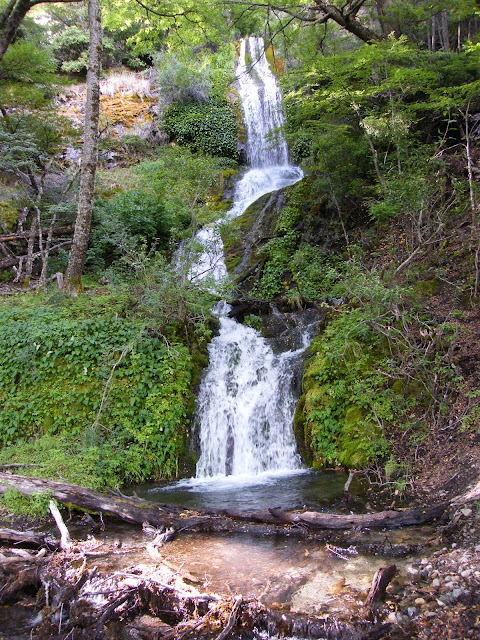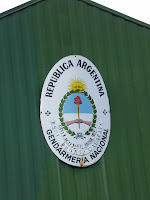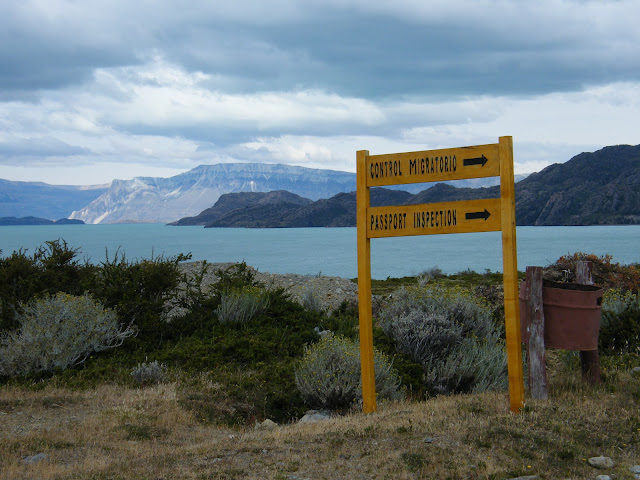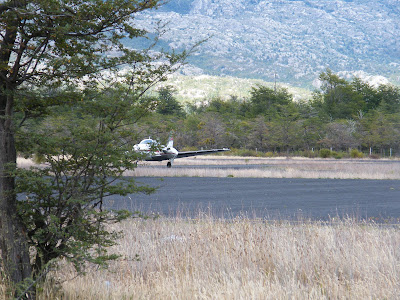Rio Nadis to Cochrane and Rio Tranquillo: Feb 6th - 10th
 |
| Chacabuco Valley |
From the border crossing at Candelaria Mancilla, it was about 150 miles to Cochrane: the first bank and ATM in Chile! There was none at Villa O'Higgins, and certainly none at the border! (Fortunately, I'd been warned about this before leaving Puerto Natales.)
The scenery on the way to Cochrane was delightful, and the paved road as we reached the town, an additional bonus.
Having completed our banking, and stocked up with some food, we continued along an equally enjoyable beautiful road, with lakes and mountains, which I really would have liked to have been able to cycle; then along the Chacabuco Valley, leading to the Argentina border, with any number of guanacos, flamingoes and black-necked swans which provided the day´s highlights.
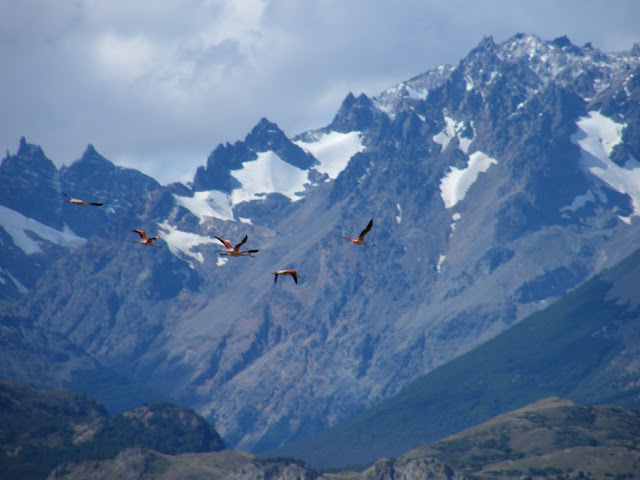 |
| Flamingoes |
 |
| Black-necked swans |
Scenery was great, all the way down, as was the weather. Happily for me, Henrietta and István like photography as much as I do, so there were plenty of opportunities to stop and take photos. I carried on with them to Rio Tranquillo, where Henrietta was keen to camp at Pudu campsite, by the lake.
| Pudu campsite: photo István |
Sadly, it started to rain there, and it was nearly the only campsite of the whole trip (as of end of Feb) where there was no shelter to retreat to - bad news the next day, when I said goodbye and thank you to Izvan and Henrique, who had to continue to Coyhaique in order to return their hire car. I´d planned to go to the Marble Caves in the morning (Tuesday 7th Feb), and they had planned to come with me, but it was wet, so they got on their way, and I waited.
Too wet to make it worthwhile trying to get up the Explorades Valley - apparently fantastic scenically, when you can see it - but hung on an extra day, and was rewarded with great weather for the Marble Caves.
 |
| Marble Caves |
For more Marble Caves pictures see:
Hit lucky again - got talking to two young German women who were travelling with their father to keep him company (their Mum hadn´t fancied the camping), and was offered a lift to Puerto Guadal, on their way to Chile Chico. This was backtracking a bit, but I was curious to see it, since that was where I would have been working, had the volunteer opportunity not fallen through. Turned out that one of the sisters was also a cellist.
Camped at an interesting ecocamp called ´Destination Non Turistico´. Up a pig of a hill, and I wasn´t impressed with the solar shower. But again, Rosia and Marcello, the couple who ran it, were really lovely people, and their homemade bread, baked in a solar oven, was just fantastic! The oven itself looked a bit like a satellite dish, except it was all chrome (or something similar). Rosia prepared the bread first thing in the morning, then so long as it was sunny, they wheeled the contraption outdoors, placed the bread in a tin, adjusted the angle, kept turning as necessary, and hey presto: after 2 hours, the bread smelled delicious, and tasted so.
 |
| Bread making in the solar oven |
 |
| Solar bread |
They also grew vegetables, which you could buy, and encouraged you to use the haybox for slow cooking. You could have a gas shower, but in their efforts to save power, they were experimenting with gravity, to avoid using the motor. Jens, a German guy I met there, decided to go for the gas shower, but had to wait about 20 minutes to start it, since it required Marcello to operate and monitor the gas in the kitchen, before he could even go into the shower room!
It was the village´s anniversary (festival) week, with celebrations supposedly being on all day as well as in the evening, so I wandered down there the afternoon that I arrived - to find that there was a funeral going on. Even from a respectful distance, it was very moving: a woman in her early 40s had died from cancer, and you could hear singing coming from the open church doors, while outside, a wooden cart decorated with flowers was waiting, along with the fire brigade. When the service was over, the coffin was carried by a team of firemen, and then half the village followed in procession along to the crematorium, with soft singing, accompanied by a guitar. She had apparently been a member of a small village folk group, and this was their tribute to her.
 |
| Lago General Carrera: famous for its colour |
´Destination No Turistico´ had promoted itself as a ´Meet the Locals´ campsite. Meeting the locals, next day, consisted of going down to the village to look for the celebrations, that turned out to be a couple of WI-type stalls, selling a bit of sewing and some jam - and then trying to find out if there was anywhere I could hire a bike. Everybody told me the same thing: bikes were for hire at Terra Luna lodge. Very soon, though, I learned that a wave of a hand towards the lake didn´t mean it was ´just down there by the lake' - the hand just indicated the vague direction. Terra Luna turned out to be about 2 miles from the village, past the turning to the campsite, and on the way to Chile Chico.
It was run by a charming lady from Annecy (Cristal) and her husband (manu), who is a climber. (They didn´t know the Idargos, who run the highly recommended Tour du Mont Blanc treks, with a mule: www.trekking-mont-blanc.com .) When I finally got there, they did indeed have bicycles, though quickly I learnt the Spanish for ´the gears don´t work´, ditto brakes. We did a lot of dashing up and down the very long hill between the lake and the road on a quad bike (with me clinging onto the back for dear life), to find a bike that was in reasonable nick, and which was also somewhere near the right size - albeit with gears and brakes not quite working. After a quick phone call from Cristal to a local garage, I was sent on an errand to the mechanic, to get it fixed. Watching him paint the bike liberally with car engine oil (including the tyres), I was not filled with confidence, but at least I could now change gear, and the dust on the road would surely sort out the oily tyres. So, everything fixed, I arranged to pick up the bike early next morning.
UNDER ATTACK!
It was still early, so decided to take a walk recommended by Marcello and Rosia. Stopped to take a photo of the lake, then noticed a bird, and decided to try and photograph it. Suddenly realised that it had filled the frame and more.
 |
| Does anyone recognise this bird? It's vicious! |
I ducked, as it just missed my head. The same thing happened again, and after the sixth time, when it was that close that I felt the swish of its wings, I realised I was under attack, and better get the hell out of there! It probably had chicks or eggs. Surprisingly, Marcello didn´t recognise the bird, even though he said he knew most of the ones around there.
I woke next morning to the sound of appalling wind, and looked out of the tent to see a threatening, overcast sky. Decided to walk to Terra Luna, and see how things were then. Alarmed to see that the wind would be coming against me, but decided it was now or never . . .
Picked up the bike, and was relieved to find that the vegetation on either side of the road was enough to give me shelter from the worst of the wind. Road surface was appalling ´ripio´(stones and gravel), but I made reasonable progess for the first hour and a half or so.
Got off to go up a hill, and a pick-up truck pulled up beside me. Decided to go for a lift up the hill, and beyond. Felt a bit guilty when I saw the German long distance cycle tourist I´d spoken to the previous day looking hopefully behind him, but continued to the top of the pass. Timing was perfect: I´d had a lift through the less interesting part, where the lake was no longer visible. Got off at the top of the pass, where the rocks and landslides were impressive, and rode (and pushed) along this scenic road for about 4 or 5 hours, the weather improving all the time, the wind changed so that now it was behind me, and the lake and mountains on the other side giving wonderful views. Quickly learnt to recognise the sign which roughly translated meant, 'Landslide area - don´t hang around.'
 |
| My trusty stead - with brakes and gears repaired (more or less) |
 |
| Road up! |
 |
| ´STOP! |
 |
| Road repairs on the way to Chile Chico |
At about lunchtime, Jens and his German passenger passed me, and stopped. The other German guy was taking the ferry from Chile Chico, but Jens was coming back, and promised to pick me up on the way back, if he saw me - he would be leaving Chile Chico at about 4pm: fantastic! Soon afterwards, a pick-up truck passed, loaded with the German cycle-tourist and all his panniers. We waved at one another, and I was glad for him that he´d got a lift.
 |
| The lake has its own microclimate, with large patches of cultivatable green |
 |
| Landslide |
Shortly before 4pm, while I was again walking up a hill, another pick-up tuck pulled up besides me, and a French guy asked me if everything was OK. It was, but I wouldn´t mind a lift up the hill . . . one of his Chilean passengers jumped out and pulled the bike into the back (thank heaven for the fact that the pick-up truck seems to be the standard type of vehicle driven by all the locals). So as to ensure that the bike was safe, I too jumped in the back - the best place to be, when the weather is warm: you get the best view, as well as the fresh air, even if it is not too comfortable. I rode with them for about 20 minutes or more, and then got out at the lovely Laguna Verde: with its beautiful pale turquoise water, a perfect place to wait for Jens: the bike had been great, but I´d done enough for today, and he would probably be along soon.
Sure enough, just ten minutes later, along came Jens - with three Israeli girl hitch-hikers in the back, but still with room for the bike and me. This had just been the most perfect day.



























